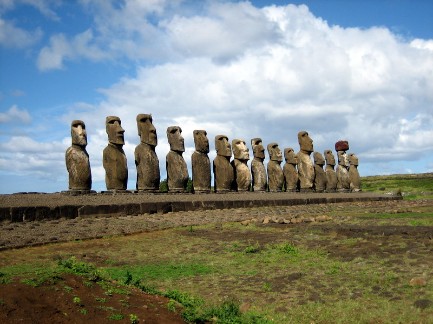
The Moai of Rapa Nui, an island in the South Pacific better known as Easter Island, are hundreds of giant stone heads built by the ancient peoples. They are all individual and are between 26 - 36 ft. (8 - 11 m.) high. The tradition of carving statues began in the 600s and lasted for almost a millennium. Contrary to popular belief, they all look towards settlements that existed when they were made, not the sea. They usually stood on a base called an ahu, beneath which was a cemetery. The moais were modelled after past leaders, the guardian ancestors of the village.
The 887 moai were relatively flat, with proud but enigmatic faces. Their heads were large, with heavy brows and elongated noses with a fish-hook shaped curl of the nostrils. The lips have a thin pout and the ears are elongated and oblong. The jaw stands out from the neck. The torsos are heavy; the arms are carved in bas-relief and rest against the body. The moai had no legs, except for one kneeling statue. They were carved out of soft volcanic rock from Ranu Raraku, a an extinct volcano with almost 300 unfinished moai.
Ranu Raraku has soft tuff perfect for statue carving and hard rock for tools. The moai carvers were master craftsmen who took advantage of fissures and colors in the rocks. When a statue was nearly finished, it was broken off and slid carefully down the slope with ropes tied to tree trunks planted in specially prepared holes in the rim of the volcano. At the crater they were righted and finished, with coral and obsidian eyes. They were carried to the ahu on their backs on top of rolling logs. Unfortunately, the need for wood would eventually lead to the destruction of the moai as, with little wood, the topsoil blew away, and with no topsoil, the farms failed. The fishing boats fell into disrepair and Rapa Nui was isolated with no food. Warfare and cannibalism broke out as the people got desperate.
The Birdman Cult now rose on a devastated and isolated island, with just enough food to support the population. The leadership of the island was determined by a rigorous challenge: whoever scaled the cliffs of Orongo, swam to one of three islets in shark-infested waters, and returned, alive, with the egg of the nestings sooty tern would be Birdman and thus ruler for a year. It was a simple, fair, and impartial solution to the tribal warfare that had so long plagued the island. Their culture might have returned to its original state had it not been for the arrival of slave traders in 1862 who took everyone who was healthy. The remains of the culture, if not the people, were destroyed by the missionaries. With Rapa Nui society in ruins, the missionaries quickly converted the population and destroyed artwork, buildings, and sacred objects, including the Rongo-Rongo tablets, the only writing the islanders had.